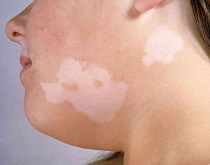![]()
 Vitiligo is caused by the destruction of melanocytes of the skin. Melanocytes are the pigment cells of the skin that produces melanin. Melanin is what causes the dark color of the skin. When melanocytes are destroyed in certain areas of the skin, the skin in those areas appear lighter than the other areas of the body. Vitiligo results in de-pigmented or white colored patches in the skin, hair or eyebrows. It can be localized to one area of the body or affect several areas of your body. This article highlights some of the important signs and symptoms of vitiligo.
Vitiligo is caused by the destruction of melanocytes of the skin. Melanocytes are the pigment cells of the skin that produces melanin. Melanin is what causes the dark color of the skin. When melanocytes are destroyed in certain areas of the skin, the skin in those areas appear lighter than the other areas of the body. Vitiligo results in de-pigmented or white colored patches in the skin, hair or eyebrows. It can be localized to one area of the body or affect several areas of your body. This article highlights some of the important signs and symptoms of vitiligo.
The exact cause of vitiligo is still unknown. Many health experts believe that the condition is caused by the body’s immune system mistakenly attacking and destroying certain cells of the body. This type of condition is referred to as an autoimmune disease or condition. Many people diagnosed with the condition have developed it at their late thirties or early forties. But there are also people who developed the condition before reaching 20-years. The condition tends to run in the family at large. The condition is not painful and doesn’t cause any discomfort. But it can cause emotional and psychological consequences to the affected people.
There is strong evidence to suggest that people with vitiligo inherit a group of genes that make them prone to depigmentation. Hence, vitiligo is considered an inherited disease. The scientific community is still studying the root causes of this condition. It may take some time to know the real causes of this condition.
A total of 65-million people or close to 1% of the world population suffer from this condition. There are 2-million people in the U.S. suffering from vitiligo currently. Half of these people have developed the condition before they reached the age of 20-years. The condition affects both sexes and almost all races in the world. But the condition is more noticeable in people with dark skin. The condition is more prevalent among people who are suffering from other autoimmune diseases such as hypothyroidism, pernicious anemia and adrenocortical insufficiency. More than 30% of patients with the condition have at least one family member suffering from the same condition. However, there are other people affected with vitiligo without any family history of the disorder.
What Are The Symptoms Of Vitiligo?
The very first symptom to appear is the depigmentation of the skin. The patient finds white patches in some areas of the body. It can be on the skin, hair or even the eyebrows. These patches commonly appear in sun exposed areas of the body. The hands, feet, face, arms and lips are some of the most common places for such patches to appear. The mouth, eyes, groin, armpits, nostrils, genitals, rectum and navel are some of the other places where the patches can appear. Vitiligo appears in three patterns most of the time. The white patches may appear in one or few areas in the focal pattern. Segmental patterns refer to white patches appearing only on one side of the body. When it comes to the generalized pattern, you find white patches appearing symmetrically on both sides of the body.
People with dark skin can notice a loss of color inside their mouth too. Some of you may develop premature graying of the scalp hair, eyebrows, beard and eyelashes. The disorder is considered a progressive disease meaning the white patches can spread to other areas of the body with time. Some people take years for the condition to spread. But others may see the condition spreading quite rapidly.
Physical examinations, medical history and laboratory tests are considered when diagnosing the disease. The doctor may suspect the condition by examining the white patches on a patient’s skin. If suspected of the condition, the doctor will ask for your medical history and conduct some laboratory tests to confirm the disease. The biggest problem occurs with the emotional and psychological damage caused by the condition. Many patients shy away from society because of their condition. This is the first line of treatment for the condition.
The aforementioned information provides a comprehensive overview of the signs and symptoms of vitiligo. We hope that this info was helpful for you to understand this condition better.
All the best!



 OneCareNow is a general weblog that was created by several writers with a specific goal in mind: To offer one place that covers important topics which people really care about.
OneCareNow is a general weblog that was created by several writers with a specific goal in mind: To offer one place that covers important topics which people really care about.



![Back Pain Breakthrough by Palmer & Dr. Young [2024 Review]](https://www.onecarenow.org/wp-content/uploads/2021/02/Back-Pain-Breakthrough-Young-Amy-50x50.png)
![Vincent’s Midas Manifestation System Review [Updated 2024]](https://www.onecarenow.org/wp-content/uploads/2021/02/Midas-Manifestation-50x50.png)
![The NEW Happiness Code by David [Updated 2024 Review]](https://www.onecarenow.org/wp-content/uploads/2021/01/The-NEW-Happiness-Code-50x50.png)
![Michael Christianson’s Manifestation Sigil Review [2024]](https://www.onecarenow.org/wp-content/uploads/2021/01/Manifestation-Sigil-50x50.png)
